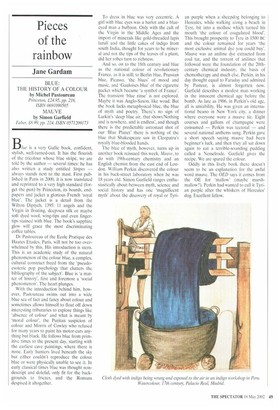Pieces of the rainbow
Jane Gardam
BLUE: THE HISTORY OF A COLOUR by Michel Pastoureau Princeton, £24.95, pp. 216, ISBN 0691090505 MAUVE by Simon Garfield
Faber. £8.99, pp. 224, ISBN 0571209173
Blue is a very Gallic book, confident, stylish, well-turned-out. It has the flourish of the tricolour whose blue stripe, we are told by the author — several times: he has also written a study entitled Stripes — always stands next to the mast. First published in Paris in 2000, it is now translated and reprinted to a very high standard (forget the pun) by Princeton, its boards, endpapers and jacket a glorious French 'royal blue'. The jacket is a detail from the Wilton Diptych, 1395: 11 angels and the Virgin in floating, deep-sea silk or maybe soft dyed wool, wing-tips and even fingertips stained with blue. The book's sapphire glow will grace the most discriminating coffee tables.
Dr Pastoureau of the Ecole Pratique des Hautes Etudes, Paris, will not be too overwhelmed by this. His introduction is stern. This is an academic study of the natural phenomenon of the colour blue, a complex, cultural construct freed from the 'pseudoesoteric pop psychology that clutters the bibliography of the subject'. Blue is 'a matter of history', first and foremost a 'social phenomenon'. The heart plunges.
With the introduction behind him, however, Pastoureau swims out into a wide blue sea of fact and fancy about colour and sometimes allows himself to float off down interesting tributaries to explore things like 'absence of colour' and what is meant by 'moral colour', the Puritan suspicion of colour and Morris of Cowley who refused for many years to paint his motor-cars anything but black. He follows blue from primitive times to the present day, starting with the earliest cave paintings, where there is none. Early hunters lived beneath the sky but either couldn't reproduce the colour blue or were physically unable to see it. In early classical times blue was thought nondescript and doleful, only fit for the backgrounds to friezes, and the Romans despised it altogether.
To dress in blue was very eccentric. A girl with blue eyes was a harlot and ,a blueeyed man a buffoon. Only with th& cult of the Virgin in the Middle Ages and the import of minerals like gold-threaded lapis lazuli and the little cakes of indigo from south India, thought for years to be mineral and not the tips of the leaves of a plant, did her robes turn to richness.
And so, on to the 18th century and blue as the national colour of revolutionary France, as it is still; to Berlin blue, Prussian blue, Picasso. 'the blues' of mood and music, and `Gauloises blue' of the cigarette packet which became 'a symbol of France'. The transient 'blue rinse' is not explored. Maybe it was Anglo-Saxon, like woad. But the book lacks metaphysical blue, the blue of myth and poetry. There's no sign of Larkin's 'deep blue air, that shows/Nothing and is nowhere, and is endless', and though there is the predictable astronaut shot of our 'Blue Planet' there is nothing of the blue that Shakespeare saw in Cleopatra's royally blue-blooded hands.
The blue of myth, however, turns up in another book reissued this week, Mauve, to do with 19th-century chemistry and an English chemist from the east end of London. William Perkin discovered the colour in his back-street laboratory when he was 18 years old. Simon Garfield ranges enthusiastically about between myth, science and social history and has one 'magnificent myth' about the discovery of royal or Tyri
an purple when a sheepdog belonging to Hercules, while walking along a beach in Tyre, bit into a mollusc which turned his mouth the colour of coagulated blood'. This brought prosperity to Tyre in 1500 BC and the colour remained for years 'the most exclusive animal dye you could buy'. Mauve was an aniline dye extracted from coal tar, and the torrent of anilines that followed were the foundation of the 20thcentury chemical industry, the basis of chemotherapy and much else. Perkin, in his day thought equal to Faraday and admired by Pasteur, is almost forgotten now. Garfield describes a modest man working in the innocent chemical age before the bomb. As late as 1906. in Perkin's old age, all is amiability. He was given an international beano in New York city, a dinner where everyone wore a mauve tie. Eight courses and gallons of champagne were consumed — Perkin was teetotal — and several national anthems sung. Perkin gave a short speech saying mauve had been beginner's luck, and then they all sat down again to eat a terrible-sounding pudding called a Nesselrode. Garfield gives the recipe. We are spared the colour.
Oddly in this lively book there doesn't seem to be an explanation for the awful word mauve. The QED says it comes from the OE for 'mallow' (maybe marshmallow?). Perkin had wanted to call it Tyrian purple after the whiskers of Hercules' dog. Excellent fellow.














































































 Previous page
Previous page